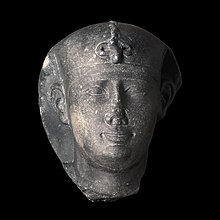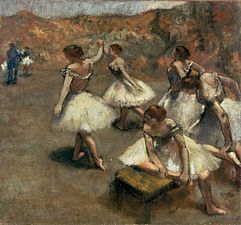Museum of Fine Arts of Lyon
This article needs additional citations for verification. (March 2010) |
Musée des Beaux-Arts de Lyon (French) | |
 The Museum of Fine Arts of Lyon | |
 Interactive fullscreen map | |
| Established | 1801 |
|---|---|
| Location | 20, place des Terreaux 69001 Lyon, France |
| Coordinates | 45°46′1″N 4°50′1″E / 45.76694°N 4.83361°E |
| Type | Art museum |
| Website | mba-lyon.fr |
The Museum of Fine Arts of Lyon (French: Musée des Beaux-Arts de Lyon) is a municipal museum of fine arts in the French city of Lyon. Located near the Place des Terreaux, it is housed in a former Benedictine convent which was active during the 17th and 18th centuries. It was restored between 1988, and 1998, remaining open to visitors throughout this time despite the ongoing restoration works. Its collections range from ancient Egyptian antiquities to the Modern art period, making the museum one of the most important in Europe. It also hosts important exhibitions of art, for example the exhibitions of works by Georges Braque and Henri Laurens in the second half of 2005, and another on the work of Théodore Géricault from April to July 2006. It is one of the largest art museums in France.[1]
Buildings
Abbey
Until 1792, the buildings belonged to the Royal
The Palais du commerce et des Arts
The expulsion of the nuns and the destruction of the église Saint-Saturnin date to the French Revolution, though the abbey's other church (the église Saint-Pierre) still exists and now houses 19th and 20th century sculptures. After the Revolution, the remaining buildings housed the Palais du Commerce et des Arts, at first made up of works confiscated from the clergy and nobility but later becoming more multi-disciplinary. For example, it gained archaeology and natural history collections and those of the Académie des Sciences et des Lettres. The imperial drawing school was created in 1805, in the Palais du Commerce et des Arts to provide Lyon's silk factories with designers, giving birth to the famous Lyon School. In 1860, the Chambre de Commerce left the Palais Saint-Pierre and the establishment became the Palais des Arts. From 1875, the museum's collections underwent a major expansion and had to be expanded — the staircase by Pierre Puvis de Chavannes dates to this era.
The Musée des Beaux-Arts
The collections were opened up considerably at the start of the 20th century, leading to the Palais des Arts becoming the Musée des Beaux-Arts. The building acquired its present layout in the mid-1990s, after the completion of several restoration projects.
Collections
Paintings
The paintings department has European 14th- to mid-20th-century paintings. They are arranged chronologically and by major schools in 35 rooms. The collection features :
- Ancient French painting (16th to 18th century) (Claude Joseph Vernetetc.).
- 19th-century French painting (Van Goghetc.) ;
- 14th- to 18th-century Italian painting (Giandomenico Tiepoloetc.) ;
- Ancient Spanish painting (mainly 17th century) (El Greco, Jusepe de Ribera, Francisco de Zurbarán etc.) ;
- Ancient German, Flemish and Dutch painting (mainly 16th and 17th centuries) ( etc.);
- 20th-century painting (including Paris Schooletc.);
-
The Nativity, Lorenzo Costa (c 1490)
-
Danae, Tintoretto (c 1570)
-
Bathsheba at Bath, Veronese(c 1575)
-
Danseuses sur scène, Edgar Degas (c 1889)
-
La Lecture, Henri Fantin-Latour(1877)
-
Virgin and Child with angels,Quentin Metsys(c 1509)
-
Crucifixion, Simon Vouet (c 1636-37)
-
Saint Francis, Francisco de Zurbarán (c 1645)
-
The Death of Sophonisba, Mattia Preti (c 1665)
Sculptures
Most of the collection is displayed in two sections: on the ground floor are Medieval and Renaissance sculptures and stuccos of the old baroque refectory; and in the abbey's church are sculptures from the 19th and early 20th centuries.
At the heart of the abbey, the former cloister is now a municipal garden, right in the centre of the town, on the peninsula. It is decorated with several 19th century statues:
- two sculptures by Auguste Rodin : The shadow, or Adam (1902) and The temptation of Saint Anthony (1900) ;
- a sculpture by Democrites meditating on the seat of the soul(1864) ;
- a sculpture by Emile Antoine Bourdelle representing Carpeaux at work (1909) ;
- a Venus (1918–1928) by Aristide Maillol ;
- an Odalisque (1841) by James Pradier,
- a group by Antoine Etex representing Cain and His Race Cursed By God
-
Carpeaux au travail, sculpted by Antoine Bourdelle, in homage to Jean-Baptiste Carpeaux.
Antiquities
Egypt
The highlights of the collection are its display of sarcophaguses and the
The collection has 600 works displayed in 9 rooms, in a thematic and chronological sequence:
- Room 1 : Life After Death
The development of funerary practices are explored via a display of26th Dynasty, as well as a Roman-era shroud.
- Room 2 : The divine and its rites
Decorations from a temple are recreated along the length of this room, culminating with the gates ofRamses VI in pink granite and the outline of the statue of Commodusas pharaoh document this aspect of Egyptian art.
- Room 3 : The cult of the divine
Entered through the gate of Ptolemy IV, at the centre of this room is a support from a28th Dynasty, also found in Koptos.

- Room 4 : Images and emblems of the divine
This room's three cases contain a collection of bronze statuettes of Gods from the Egyptian pantheon, with a rare representation of30th Dynasty, attributed to Nectanebo II, a Middle Kingdom bust (characterised by its over-large ears), and a scarab with the name of Amenhotep II.
-
Bust of a pharaoh, Middle Kingdom
-
Statuette of the child Horus, Late Period
-
Statuette of the Nile God Hâpy, Late Period
- Room 5 : Pharaoh and his servants
In one case are 18 wooden models obtained from tombs from the time of theAssiout. They represent scenes from everyday life such as grazing cattle, or beer-making. In the opposite case are two displays: one on writing, and the other on the pharaoh's servants. The latter has, among other objects, a limestone statue of an anonymous Old Kingdomcouple, a Ptolemaic male bust, and a fragment of a statuette of a kneeling scribe.
- Room 6 : Stelae
Arranged around a wooden statue of Osiris are four Middle KingdomAmenophis III, which retains traces of its polychromy.
- Room 7 : Everyday life
One case contains 14 protohistoric and pre-dynastic vases, whilst another shows a selection of vases spanning the New Kingdom to the28th Dynasty, perhaps part of the ornamentation of a harp. It also contains everyday objects like sandals, mirrors, jewellery, and even a stool.
- Room 8 : Egypt and the Greeks - Egypt and Rome
This room explores Greek and Roman influences on Egyptian art. This is especially prevalent in private works of art such as a series of terracotta figurines of Egyptian Gods with Hellenistic traits, and five 2nd and 3rd century funerary stelae from Koptos showing Palmyrenean influence.
- Room 9 : Egypt and the Roman Empire - Coptic Christianity
This room houses gold-plated funerary masks from theCopticcivilisation, including a fragment of the famous "shawl of Sabina".
Near East and Middle East
One room contains cylinder seals, clay tablets and bas-reliefs from the Sumerian, Assyrian and Babylonian civilisations, as well as Luristan bronzes, ceramics and statuettes from Cyprus and a fine collection of Syrian objects (including an anthropoid sarcophagus and a marble bas-relief).
Ancient Greece and Italy
A single room is devoted to the main work in this department, the 6th century BC marble
Roman sculpture is also presented across several rooms - marble statues (a torso of Venus, a child on a cockerel, statues of draped figures etc.) and also small bronze figurines of Gods from the Roman Pantheon such as Mercury, Venus, Mars etc.
The Gallo-Roman collections of the city of Lyon, previously presented at the Museum of Fine Arts and the Antiquarium, were transferred in 1975 at the Lugdunum museum on the hill of Fourvière near the Roman theatre and Odeon.
Objets d’Art
This department's collection ranges from the Middle Ages to the 20th century and includes:
- Byzantine ivories
- Limoges enamels
- Renaissance faience and maiolica
- Art Nouveau room by Hector Guimard
- Islamic art
- Far East ceramics
- Chinese, Korean and Japanese stoneware (since 1917) - rare pieces illustrating the tea ceremony, displayed next to the Art Nouveauceramics they inspired.
- The Death of Polydorus, tapestry
- Silk fabrics produced by Lyon's silk manufacturing trade, including works by Jean-François Bony.[3]
Coins and medals
Lyon's "médaillier" is the second largest one in France after that in Paris, with nearly 50,000 coins, medals, seals and other objects. It is known at a European level and has held a prominent place in the numismatic world from its beginnings in the 19th century to recent discoveries of the treasuries of the Terreaux and the Célestins.[4]
Graphic arts
This department was created at the start of the 19th century and includes works on paper - drawings, prints, engravings, watercolours etc. - based on line rather than colour. In all it more than 8,000 works, including ones by
Magazine
On the initiative of René Jullian, in 1952 the Bulletin des musées lyonnais was created, and 8 years later changed its name to Bulletin des musées et monuments Lyonnais. In 2003 it changed to an annual publication and again changed its name, to Cahiers du musée des Beaux-Arts de Lyon.
Collection
- Cloth of St Gereon, a fragment the museum has in its inventory. It is one of the oldest European tapestries in existence.
Notes
- ^ "30 Masterpieces From the Lyon Museum of Fine Arts". Google Arts & Culture. Retrieved 2023-05-22.
- ISBN 2849751642
- ^ "Jean-François Bony, l'artiste au service de Leurs Majestés". www.mtmad.fr (in French). Retrieved 2018-06-30.
- ^ root. "Présentation - Musée des Beaux Arts de Lyon". www.mba-lyon.fr (in French). Retrieved 2018-02-28.
External links
- Official Musée des Beaux-Arts de Lyon website—(in French)
- Ville de Lyon.fr: city's official Musée des Beaux-Arts webpage—(in French)
- Aerial view on Wikimapia (Google maps + Wiki)
- Virtual tour of the Museum of Fine Arts of Lyon provided by Google Arts & Culture
 Media related to Musée des Beaux-Arts de Lyon at Wikimedia Commons
Media related to Musée des Beaux-Arts de Lyon at Wikimedia Commons














